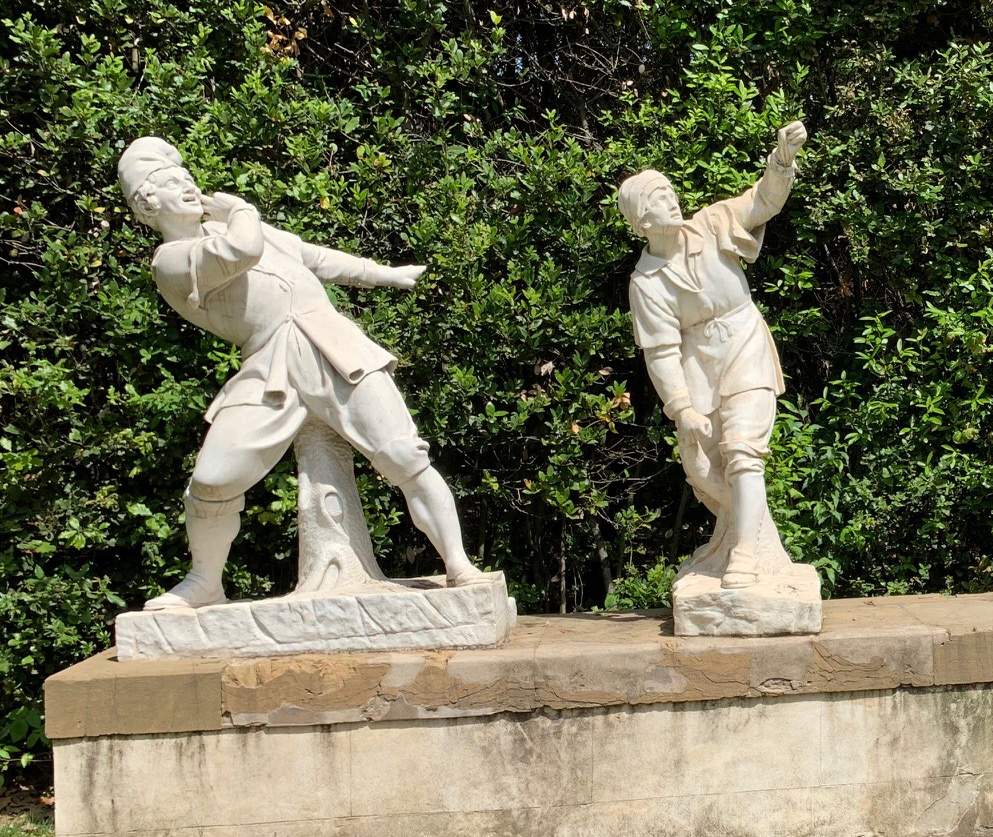The restoration of the sculpture depicting the Owl’s Game, a work by Giovanni Battista Capezzuoli (Florence, 1723 - 1810) that adorns the Boboli Gardens, has been completed in Florence. It is a white marble statue that was commissioned around 1775 by Grand Duke Pietro Leopoldo of Lorraine: the work, which was intended to replace a stone original that was in a heavy state of conservation decay at the time, is located between the Prato delle Colonne and the entrance to Porta Romana, in front of the Caramogi group by Tomolo Ferrucci del Tadda. The sculpture depicts a young man in the act of playing the “owl”: a very simple garden game that consisted of removing the hat from the other player, who, to avoid having his head revealed, had to necessarily lower himself (this is why the character is bent on his legs). Another variation of the game involved, in a three-player version, that the one in the middle had to dodge the slaps of the other two, and that in order to get out of the position and become a slapper in turn he had to touch one of the other contenders. Originally, Capezzuoli’s group was to include three figures, but only two were made.
Restoration had become necessary because of the state of the work, which was being attacked by dirt: algae, mosses, lichens, black stains of biological origin, phenomena of decohesion of the crystalline structure, and erosion of some of the overhanging areas, due to the particular exposure to weathering inside the garden (heavy rain, humidity, heat, and frost). After careful verification of the surface strength and structural soundness, the restoration work, led by Miriam Ricci, was carried out by removing dry dust with mechanical suction and using soft brushes. This was followed by cleaning with demineralized water useful for removing the biological patinas present on the surface. Once this stage was performed, cycles of benzalkonium chloride applications with subsequent rinsing and brushing were carried out for the total removal of algae mosses and lichens, and treatment was then carried out to prevent further and future formation of such layers. The old stucco additions to the studs were also removed and replaced by new stucco more suitable for the original surface.
The work was carried out under the direction of Alessandra Griffo and was made possible by a gift from the children of the Florence Chapter of the Friends of Florence Foundation. “Inaugurating this restoration is for us a source of great pride,” stresses Friends of Florence President Simonetta Brandolini d’Adda, “because this is the first project supported by the young Friends of Florence. It represents the future not only of our Foundation, but also the opportunity to continue our mission, which is to preserve for future generations the important artistic heritage of Florence and Tuscany.”
“The interventions on the sculptures in the garden are very important,” adds the director of the Uffizi Galleries, Eike Schmidt, “because together with the marvelous arboreal and floral heritage of Boboli they constitute the soul of this unique Medici park.”
Pictured: the restored Gioco della Civetta by Giovanni Battista Capezzuoli.
 |
| Florence, Boboli Gardens, restored the Gioco della Civetta, an important 18th-century sculpture |
Warning: the translation into English of the original Italian article was created using automatic tools. We undertake to review all articles, but we do not guarantee the total absence of inaccuracies in the translation due to the program. You can find the original by clicking on the ITA button. If you find any mistake,please contact us.